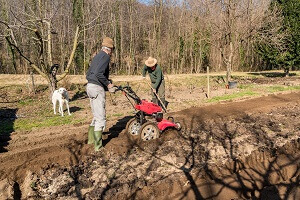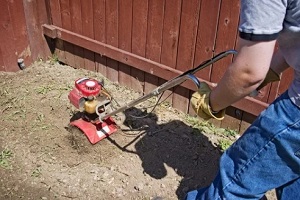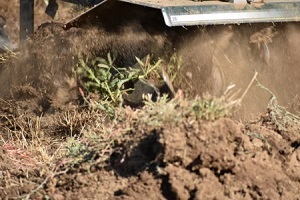 As gardening enthusiasts, we’re constantly looking for effective ways to improve our soils for the better growth and health of our plants. One common question often raised is whether to rototill the garden or not.
As gardening enthusiasts, we’re constantly looking for effective ways to improve our soils for the better growth and health of our plants. One common question often raised is whether to rototill the garden or not.
Here, we’re going to break down the specifics of rototilling, offering insight into the process, the benefits, the best times to do it, and when it may not be the best choice for you.
What Is Rototilling?
Rototilling is a process that revolves around utilizing a specific piece of gardening equipment called a rototiller, sometimes simply referred to as a tiller. This machinery is designed for soil cultivation, and it facilitates the stirring and overturning of the soil in a more efficient and less labor-intensive way compared to traditional manual methods such as using a spade or a hoe.
A rototiller is typically equipped with curved tines attached to a rotating axle, powered by gasoline or electricity. As the rototiller moves across a garden plot, the rotating tines dig into the ground, breaking up compacted soil, removing weeds, and blending various soil components together. The final result is a fine-textured and loosened soil that’s perfect for the growth of plants of all kinds.
Benefits of Rototilling
Rototilling is more than just a process for soil preparation; it can introduce numerous benefits to your garden ecosystem. Here’s a closer look at how rototilling can enhance soil productivity and health.
Promoting Superior Soil Structure and Drainage
Compact soils can hinder plant growth by creating an inhospitable environment for plant roots, impeding their access to air, water, and essential nutrients. They can also lead to poor drainage, causing water to pool on the surface instead of being absorbed. This can lead to plant diseases or “drowning” of the roots due to excessive water.
Rototilling comes to the rescue by breaking up this compacted soil, resulting in a looser, more porous structure. This transformation enhances the soil’s capacity to drain excess water and enables better root penetration. Better root growth means plants can reach deeper into the ground to access water and nutrients, enhancing their resilience and overall health.
Enabling Enhanced Nutrient Incorporation
Fertile soil is a vital factor for a successful garden. Often, we enrich the soil by adding organic matter or other soil amendments, such as compost, manure, peat moss, or fertilizers. However, merely spreading these amendments on the surface isn’t enough, as they need to interact with the soil to maximize the plants’ benefit.
Rototilling plays a crucial role here. Thoroughly blending these amendments into the soil ensures their effective incorporation. This process homogenizes the soil and increases the overall nutrient content. Consequently, plants can readily access these nutrients, leading to more robust and healthier growth.
Weed Control
 Gardens can quickly be overrun by weeds if left unchecked. These unwanted plants compete with your garden plants for light, space, water, and nutrients, leading to diminished crop yields and less robust ornamental plants.
Gardens can quickly be overrun by weeds if left unchecked. These unwanted plants compete with your garden plants for light, space, water, and nutrients, leading to diminished crop yields and less robust ornamental plants.
Rototilling offers a proven, effective solution for weed control. As the tiller’s tines churn through the soil, they chop up any weeds and bury them along the way. This disruption hampers their growth cycle, preventing them from taking over your garden. However, be careful with certain weed species that can propagate from root pieces, as tilling might inadvertently spread these weeds.
When to Rototill a Garden
Knowing when to employ the rototiller can significantly influence your garden’s overall productivity and health. Certain times of the year are more conducive for rototilling than others, depending on the season and the specific gardening task at hand.
Springtime Rototilling
Spring is often considered the prime time for rototilling. As winter subsides, soil begins to warm up and dry out, achieving an optimal moisture level that’s neither too dry nor too saturated. This provides excellent conditions for tilling, enabling the tiller to effectively break up the soil without causing compaction or dust storms.
Furthermore, spring is typically when gardeners introduce organic matter or other amendments to rejuvenate the soil for the upcoming growing season. Rototilling during this period allows you to mix these amendments thoroughly into the soil, enhancing its nutrient content and preparing it for the new plant growth cycle.
Establishing New Beds
Rototilling can be invaluable if you’re embarking on a new gardening project and need to establish a new garden bed. Undisturbed soil can often be compacted without the structure and nutrients necessary for successful plant growth.
Through rototilling, you can break up this compacted soil, introduce amendments, and thoroughly mix them in to create a fertile, well-drained garden bed. The tilling process will also uproot and disturb any previously present weeds or grasses, helping to clear the slate for your new plants.
However, it’s important to note that once your new bed is established, you might want to minimize future tilling to prevent soil structure degradation and protect beneficial soil organisms.
When Not to Rototill a Garden
While rototilling has many benefits, there are instances when it might not be the most suitable approach for maintaining your garden. The decision to till should be made carefully, considering the current state of the garden, the weather conditions, and the biological factors present within the soil.
 Wet Conditions: Tilling wet soil can cause compaction and clumping, ruining soil structure. Always wait until the soil has dried enough to crumble easily when squeezed.
Wet Conditions: Tilling wet soil can cause compaction and clumping, ruining soil structure. Always wait until the soil has dried enough to crumble easily when squeezed.- Established Perennial Beds: Tilling can disrupt the root systems of perennial plants. It’s often better to use methods like top-dressing or mulching to add nutrients to established beds.
- Presence of Beneficial Soil Organisms: Excessive tilling can disrupt soil ecosystems and harm beneficial soil organisms. Consider less disruptive maintenance methods if your soil is healthy and teeming with earthworms and other beneficial creatures.
Is Rototilling Right for You?
The importance of high-quality materials and reliable service cannot be overstated in construction. Your projects need the best resources and a team you can trust to ensure successful completion—that’s where Dirt Connections comes into play.
With a reputation for excellence and a commitment to providing top-tier materials, Dirt Connections is your go-to resource for your construction site needs. Our experienced team is ready to ensure you receive superior service from initial planning to execution.
So, whether you’re preparing a garden bed, laying a foundation for a new building, or managing a large-scale construction project, Dirt Connections is just the ally you need. Reach out to us today, and let’s build something great together.
Summary

Dirt Connections was started with one goal in mind: providing quality residential and commercial construction services to clients on time and on budget. Reach out for more information on how we can support your next project.
For your convenience our estimates are free and by appointment. Call 703-940-9949 for a free estimate today!









































